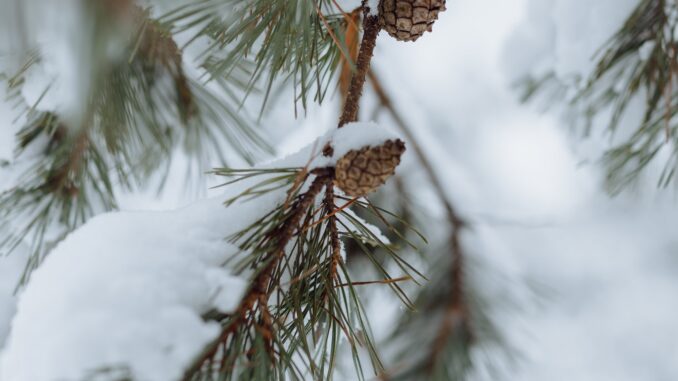

By Andrew Scott, Gardens on Spring Creek Horticulturist
In the dead of winter, there isn’t a ton of plant activity going on… or at least that’s how it seems. Evergreens carry obvious winter interest in a garden, but this is only needle-deep! The mechanisms that keep these plants going through the harshest months are even more interesting.
While several plant families are evergreen, gymnosperm trees and shrubs like pines, spruces, firs, and junipers are most representative in the Rocky Mountain region. These plants are able to dominate the canopies of montane, subalpine, and alpine regions because their needles, which are actually modified leaves, have adapted to extend their growing season past what other species can. Unlike deciduous species that drop their leaves—and a fair chunk of sequestered nutrients—every year, evergreens take up nutrients more slowly and hold onto their needles for several years. This means they can photosynthesize year-round, while deciduous trees are limited to only photosynthesizing via a thin layer of tissue under their bark during the winter.
Snow and wind are common stressors for gymnosperms at altitude. Compare a cottonwood leaf to a spruce needle: broad, flat leaves catch wind like a sail and intercept more sharp ice crystals, increasing the risk of being blown off or shredded, but thin, dense needles decrease these odds. Furthermore, with a strategy called needle packing, bundles of needles maintain a layer of unmoving air that resists changes in temperature like a jacket or coat of fur, insulating the leaves so biological processes continue. These evergreens also exhibit apical bud dominance, meaning they focus on growing a single shoot up rather than multiple shoots out. This allows new, weaker branches to remain short and better shed accumulating snow, keeping them from breaking.

With wind and snow, temperatures drop, slowing biological processes. However, by increasing the concentrations of sugars in their tissues, gymnosperm cells continue to function below freezing. As temperatures approach -25°C (-13°F), gymnosperms will break down starches to further increase this concentration of sugar. Beyond -50°C (-58°F), drastic measures take place where proteins bond with water molecules to prevent freezing; cells will also actively push water into the spaces between them to prevent damaging expansion into ice.
Gymnosperms tolerate drought well, both in winter when water is frozen and inaccessible and in summer when it’s limited. Plants have a continuous flow of water down from their roots up into the atmosphere, but if this flow gets interrupted by a lack of water (cavitation), the plant loses function, and growth is stunted. By having smaller diameter vessels than deciduous trees, water adhesion increases, and gymnosperms become less prone to cavitation in exchange for moving less water. As with cavitation, the combination of cold and high light levels can be devastating, too—just ask our giant sequoia at the Gardens on Spring Creek. To this end, gymnosperms angle their skinny needles so photons impact fewer cells in the first place, produce waxy leaf cuticles to reflect light, and use cellular antioxidants to deter ultraviolet damage that ultimately makes it through.
Winter is infamously cold, dry, and dark—conditions that seldom promote plant growth—but these clever adaptations allow evergreens to brush off the stark conditions that force their deciduous brethren into dormancy. Life in the slow lane, modifying their leaves, making natural antifreeze, and altering their internal plumbing allows these plants to thrive in environments that force them to adapt or perish.
Support Northern Colorado Journalism
Show your support for North Forty News by helping us produce more content. It's a kind and simple gesture that will help us continue to bring more content to you.
BONUS - Donors get a link in their receipt to sign up for our once-per-week instant text messaging alert. Get your e-copy of North Forty News the moment it is released!
Click to Donate
